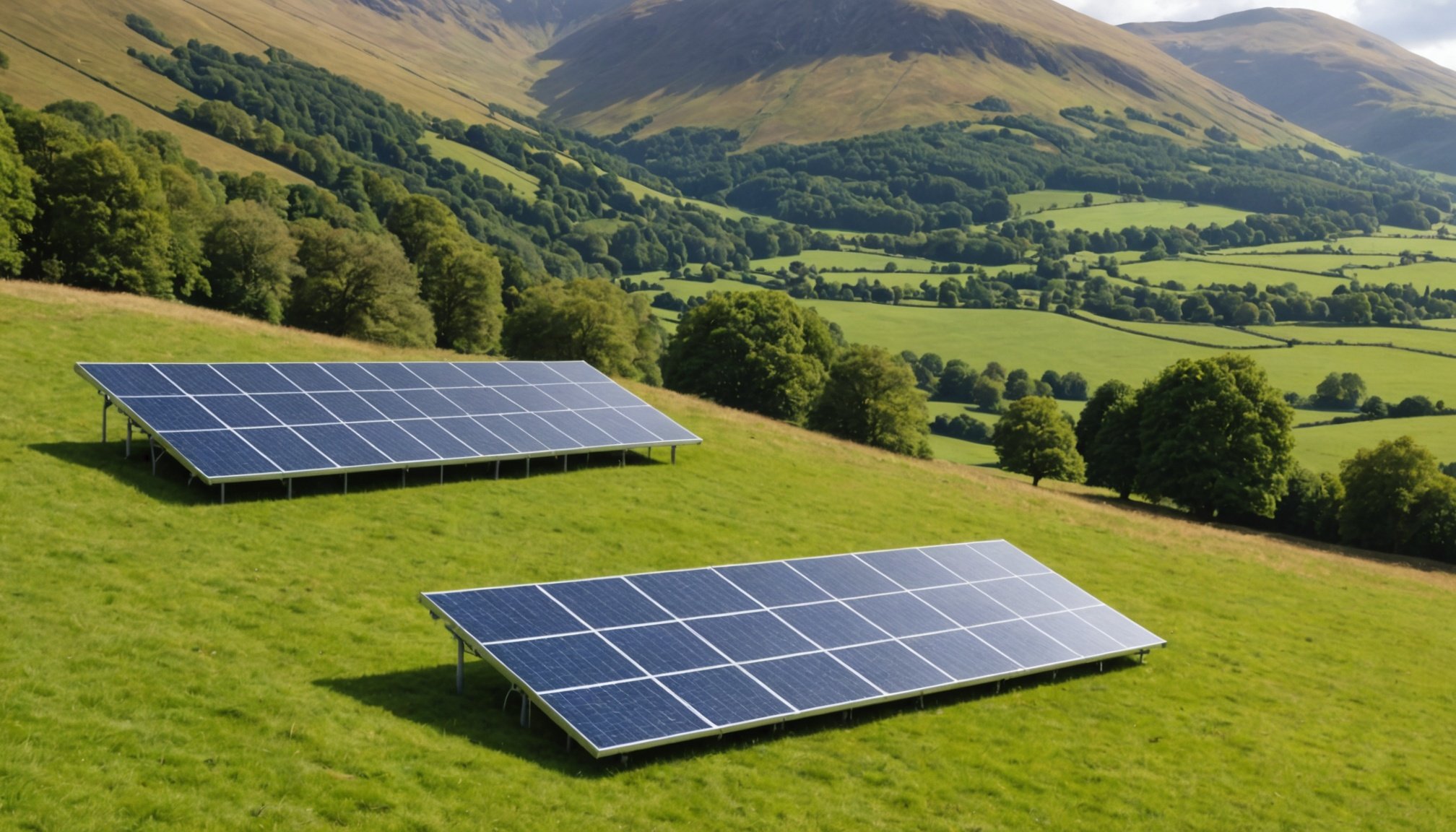Geographical Features
In the Lake District, topography plays a vital role in the selection of sites for solar energy projects. The unique landscape, characterized by a mix of valleys and mountains, significantly influences sunlight exposure. Areas situated at higher elevations often receive more direct sunlight, crucial for optimizing solar energy conversion. Thus, when considering geographical features, elevation is a key factor in determining a site’s solar potential.
The terrain is equally important. Flat areas may benefit from easier installation and maintenance of solar panels, yet these locations can be at a disadvantage due to potential shading from surrounding peaks. Additionally, the presence of natural obstacles, such as dense tree coverage or existing buildings, can impede solar access by casting shadows over solar panels. Therefore, these obstacles must be meticulously evaluated to ensure maximum exposure to sunlight.
A lire en complément : Essential Legal Requirements for Property Subdivision in Manchester: A Comprehensive Guide
A strategic approach involves identifying sites where elevation and terrain align optimally, providing a balance between ease of installation and maximum sunlight exposure. This involves using tools such as topographic maps and sunlight analysis software to map out the best locations free of shade and with high solar energy potential. By doing so, solar installations can effectively harness the solar resources available in the Lake District, contributing to sustainable and efficient energy solutions.
Sunlight Exposure
Exploring solar radiation assessment involves understanding various components crucial for efficient solar energy utilisation. Let’s delve into the types of solar radiation and their impact on energy solutions.
A lire en complément : Key Considerations for Your Property Survey When Purchasing Near the River Thames
Types of Solar Radiation
Solar radiation consists primarily of direct and diffuse sunlight. Direct sunlight reaches the Earth’s surface without scattering, providing intense energy. In contrast, diffuse sunlight results from scattered rays, often seen on cloudy days. The efficiency of solar panels hinges on their ability to harness both types, albeit more so from direct sunlight due to its higher concentration and energy yield.
Seasonal Variations in Sunlight
Understanding seasonal patterns is vital in solar radiation assessment. Different seasons lead to varying sunlight intensity and duration due to the Earth’s tilt. Generally, longer days in summer contribute to increased solar energy, while shorter days in winter pose challenges. This necessitates adjustments in energy collection strategies to optimise solar power throughout the year.
Techniques to Measure Sunlight Exposure
Assessing sunlight availability employs various tools and methods. Devices like pyranometers and solarimeters help in gauging solar intensity accurately. Sophisticated software models also predict solar exposure by simulating climatic conditions over time. This enables precise planning for solar panel installations and maximises energy production efficiency. Understanding these techniques empowers better decision-making in solar energy investments.
Local Regulations
Navigating solar energy regulations in the Lake District can be a meticulous task. Understanding the local government’s policies concerning solar installations is crucial for anyone interested in renewable energy projects in this picturesque region. The zoning laws specific to this area have been crafted to ensure that solar energy projects align with both environmental goals and the aesthetic nature of the community.
Zoning laws in the Lake District typically require individuals or companies to obtain specific permits before proceeding with solar installations. These permits ensure that installations are not only safely executed but are also in harmony with the unique landscape of the region. Permit requirements may vary depending on the scale of the project and its location.
The role of community guidelines cannot be overlooked. They serve as a framework to balance the need for renewable energy with the preservation of the district’s natural beauty. Community guidelines often provide insight into acceptable practices and standards for solar energy projects, preventing conflicts and promoting sustainable development.
Understanding these government policies, zoning laws, and community guidelines will empower potential solar energy users to embark on projects with greater confidence and predictability.
Environmental Impacts
Solar energy projects offer significant ecological advantages, but their implementation requires careful consideration of potential challenges. Balancing ecological considerations for solar sites is crucial to prevent unintended environmental consequences.
Biodiversity and Habitat Assessment
A comprehensive biodiversity and habitat assessment is vital for understanding the potential effects of solar installations. This process involves evaluating the existing flora and fauna, identifying sensitive species, and determining the ecological value of the area. Such assessments help ensure that solar sites do not disrupt endemic species or critical habitats.
Potential Environmental Risks
Solar projects can pose risks like habitat loss and alteration of ecosystems. Interventions may lead to changes in land use, impacting local biodiversity. Furthermore, water and soil quality must be monitored to prevent detrimental effects. For example, runoff from construction sites could lead to soil erosion or water contamination.
Mitigation Strategies for Environmental Impacts
To mitigate these risks, thorough strategies are required. Implementing buffer zones around sensitive areas and using low-impact materials can minimize habitat disruption. Additionally, employing techniques such as smart landscaping or revegetation helps preserve local ecosystems. Regular monitoring of soil and water quality can further ensure long-term ecological stability.
Technical Requirements
When it comes to implementing solar panel installation specifications in the Lake District, several essential factors must be considered. This picturesque region presents unique challenges due to its weather conditions, highlighting the importance of choosing the right inverter and battery systems. Selecting these components wisely not only enhances system efficiency but also ensures reliability despite the area’s often cloudy skies.
Solar panels designed for high-efficiency performance in low-light conditions are particularly suitable for this region. Inverters should possess a high tolerance to fluctuations in sun exposure, converting direct current (DC) from the panels into usable alternating current (AC) efficiently. Furthermore, robust and durable battery systems are vital for storing excess energy to maintain consistency in power supply during overcast periods.
Maintenance considerations for solar energy systems in the Lake District are non-negotiable to ensure long-term sustainability. Routine checks to clean panels and inspect the wiring can prevent potential issues. This proactive approach helps maintain optimal energy production, delivering reliable power even on dreary days. Regular maintenance further extends the lifespan of the installation, maximizing the return on investment.
In summary, adapting a solar energy system to the Lake District involves careful planning and specialized components to overcome regional challenges effectively.
Practical Tips and Tools
For those navigating through the solar site selection process, leveraging the right resources is essential to making informed choices.
Evaluation Tools and Software
Using evaluation tools and software can greatly streamline the process. These resources help assess factors such as sunlight exposure, roof angle, and local climate conditions. Tools like PVWatts Calculator and Solar Pathfinder are highly recommended. They enable you to simulate different scenarios, offering accurate predictions on energy output and savings. Choosing an effective tool can save time and ensure your investment pays off in the long run.
Case Studies of Successful Solar Installations
Exploring case studies from similar settings provides valuable insights. These examples not only highlight successful projects but also offer lessons learned that can be applied to new installations. By studying how others have effectively navigated challenges, such as regulatory hurdles or funding issues, you gain practical knowledge that could potentially save you from costly mistakes.
Community Resources and Expert Consultations
Engaging with community resources and seeking expert consultations can be incredibly beneficial. Local organizations, such as environmental non-profits or government energy departments, often provide workshops and guides. Expert consultations, meanwhile, offer personalized advice tailored to your specific situation, enhancing the effectiveness of your solar project.











